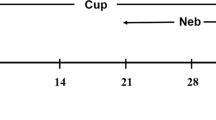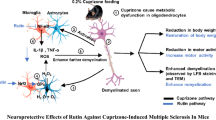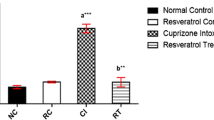Abstract
Multiple sclerosis is a chronic inflammatory neurodegenerative disease of the central nervous system which injures the myelin sheath. Telmisartan and nifedipine are antihypertensive drugs that recently showed neuroprotective properties against neurodegenerative diseases. This study evaluated the neuroprotective effect of telmisartan or nifedipine in cuprizone-induced demyelination in mice by examining the underlying mechanisms. C57BL/6 mice received a diet containing 0.7% (w/w) cuprizone for 7 days followed by 3 weeks on a 0.2% cuprizone diet. Telmisartan (5 mg/kg/day, p.o.) or nifedipine (5 mg/kg/day, p.o.) was administered for 3 weeks starting from the second week. Telmisartan or nifedipine improved locomotor activity and enhanced motor coordination as demonstrated by open field, rotarod, and grip strength tests. Furthermore, telmisartan or nifedipine restored myelin basic protein mRNA and protein expression and increased luxol fast blue-staining intensity. Telmisartan or nifedipine attenuated cuprizone-induced oxidative stress and apoptosis by decreasing brain malondialdehyde and caspase-3 along with restoring reduced glutathione and brain-derived neurotrophic factor levels. Telmisartan or nifedipine exerted an anti-inflammatory effect by reducing the expression of nuclear factor kappa B (NF-κB p65) as well as pro-inflammatory cytokines and elevating the expression of IκB-α. In parallel, telmisartan or nifedipine upregulated the expression of nuclear factor erythroid 2-related factor 2 (Nrf2) and the levels of heme oxygenase-1 and NADPH quinone oxidoreductase 1 enzymes. In conclusion, the current study provides evidence for the protective effect of telmisartan and nifedipine in cuprizone-induced demyelination and behavioral dysfunction in mice possibly by modulating NF-κB and Nrf2 signaling pathways.






Similar content being viewed by others
Data Availability
The analyzed data sets generated during the present study are available from the corresponding author on reasonable request.
References
Jolanda Münzel, E., and Anna Williams. 2013. Promoting remyelination in multiple sclerosis—recent advances. Drugs 73: 2017–2029. https://doi.org/10.1007/s40265-013-0146-8.
Gilmour, Heather, Pamela L. Ramage-Morin, and Suzy L. Wong. 2018. Multiple sclerosis: prevalence and impact. Health Reports 29: 3–8.
GBD 2016 Neurology Collaborators. 2019. Global, regional, and national burden of neurological disorders, 1990-2016: a systematic analysis for the Global Burden of Disease Study 2016. The Lancet. Neurology 18: 459–480. https://doi.org/10.1016/S1474-4422(18)30499-X.
Brück, Wolfgang, Ramona Pförtner, Trinh Pham, Jingya Zhang, Liat Hayardeny, Victor Piryatinsky, Uwe-Karsten Hanisch, et al. 2012. Reduced astrocytic NF-κB activation by laquinimod protects from cuprizone-induced demyelination. Acta Neuropathologica 124: 411–424. https://doi.org/10.1007/s00401-012-1009-1.
Wingerchuk, Dean M., and Brian G. Weinshenker. 2016. Disease modifying therapies for relapsing multiple sclerosis. BMJ (Clinical research ed.) 354: i3518. https://doi.org/10.1136/bmj.i3518.
Skripuletz, T., J.H. Bussmann, V. Gudi, P.N. Koutsoudaki, R. Pul, D. Moharregh-Khiabani, M. Lindner, and M. Stangel. Cerebellar cortical demyelination in the murine cuprizone model. Brain Pathology 20: 301–312. https://doi.org/10.1111/j.1750-3639.2009.00271.x.
Matsushima, G.K., and P. Morell. 2001. The neurotoxicant, cuprizone, as a model to study demyelination and remyelination in the central nervous system. Brain Pathology (Zurich, Switzerland) 11: 107–116. https://doi.org/10.1111/j.1750-3639.2001.tb00385.x.
Fischer, Henrike J., Nils Schweingruber, Fred Lühder, and Holger M. Reichardt. 2013. The potential role of T cell migration and chemotaxis as targets of glucocorticoids in multiple sclerosis and experimental autoimmune encephalomyelitis. Molecular and Cellular Endocrinology 380: 99–107. https://doi.org/10.1016/j.mce.2013.04.001.
Praet, Jelle, Caroline Guglielmetti, Zwi Berneman, Annemie Van der Linden, and Peter Ponsaerts. 2014. Cellular and molecular neuropathology of the cuprizone mouse model: clinical relevance for multiple sclerosis. Neuroscience & Biobehavioral Reviews 47: 485–505. https://doi.org/10.1016/j.neubiorev.2014.10.004.
Li, Jun, Juraj Culman, Heide Hörtnagl, Yi Zhao, Nadezhda Gerova, Melanie Timm, Annegret Blume, et al. 2009. The cuprizone animal model: new insights into an old story. Acta Neuropathologica 118: 723–736. https://doi.org/10.1007/s00401-009-0591-3.
Yue, Yuan, Sarrabeth Stone, and Wensheng Lin. 2018. Role of nuclear factor κB in multiple sclerosis and experimental autoimmune encephalomyelitis. Neural Regeneration Research 13: 1507. https://doi.org/10.4103/1673-5374.237109.
Mc Guire, Conor, Marco Prinz, Rudi Beyaert, and Geert van Loo. 2013. Nuclear factor kappa B (NF-κB) in multiple sclerosis pathology. Trends in Molecular Medicine 19: 604–613. https://doi.org/10.1016/j.molmed.2013.08.001.
Hoffmann, Alexander, and David Baltimore. 2006. Circuitry of nuclear factor kappaB signaling. Immunological Reviews 210: 171–186. https://doi.org/10.1111/j.0105-2896.2006.00375.x.
Leibowitz, Saskia M., and Jun Yan. 2016. NF-κB Pathways in the pathogenesis of multiple sclerosis and the therapeutic implications. Frontiers in Molecular Neuroscience 9. https://doi.org/10.3389/fnmol.2016.00084.
Zhou, Yifan, Chunping Cui, Xiaoyu Ma, Wenjing Luo, Song Guo Zheng, and Wei Qiu. 2020. Nuclear factor κB (NF-κB)-mediated inflammation in multiple sclerosis. Frontiers in Immunology 11: 391. https://doi.org/10.3389/fimmu.2020.00391.
Gopal, Sreeja, Alvydas Mikulskis, Ralf Gold, Robert J. Fox, Katherine T. Dawson, and Lakshmi Amaravadi. 2017. Evidence of activation of the Nrf2 pathway in multiple sclerosis patients treated with delayed-release dimethyl fumarate in the Phase 3 DEFINE and CONFIRM studies. Multiple Sclerosis Journal 23: 1875–1883. https://doi.org/10.1177/1352458517690617.
Gold, Ralf, Ludwig Kappos, Douglas L. Arnold, Amit Bar-Or, Gavin Giovannoni, Krzysztof Selmaj, Carlo Tornatore, et al. 2012. Placebo-controlled phase 3 study of oral BG-12 for relapsing multiple sclerosis. New England Journal of Medicine 367: 1098–1107. https://doi.org/10.1056/NEJMoa1114287.
Li, Qin-Ying, Qiang Miao, Ruo-Xuan Sui, Cao Liang, Cun-Gen Ma, Bao-Guo Xiao, Wei Xiao, and Yu. Wen-Bo. 2019. Ginkgolide K supports remyelination via induction of astrocytic IGF/PI3K/Nrf2 axis. International Immunopharmacology 75: 105819. https://doi.org/10.1016/j.intimp.2019.105819.
Michaličková, Danica, Tomáš Hrnčíř, Nikolina Kutinová Canová, and Ondřej Slanař. 2020. Targeting Keap1/Nrf2/ARE signaling pathway in multiple sclerosis. European Journal of Pharmacology 873: 172973. https://doi.org/10.1016/j.ejphar.2020.172973.
Gohlke, P., S. Weiss, A. Jansen, W. Wienen, J. Stangier, W. Rascher, J. Culman, and T. Unger. 2001. AT1 receptor antagonist telmisartan administered peripherally inhibits central responses to angiotensin II in conscious rats. The Journal of Pharmacology and Experimental Therapeutics 298: 62–70.
Malik, Salma, Kapil Suchal, Nanda Gamad, Amit Kumar Dinda, Dharamvir Singh Arya, and Jagriti Bhatia. 2015. Telmisartan ameliorates cisplatin-induced nephrotoxicity by inhibiting MAPK mediated inflammation and apoptosis. European Journal of Pharmacology 748: 54–60. https://doi.org/10.1016/j.ejphar.2014.12.008.
Babu, C. Saravana, and M. Ramanathan. 2009. Pre-ischemic treatment with memantine reversed the neurochemical and behavioural parameters but not energy metabolites in middle cerebral artery occluded rats. Pharmacology Biochemistry and Behavior 92: 424–432. https://doi.org/10.1016/j.pbb.2009.01.010.
Daschil, Nina, and Christian Humpel. 2014. Nifedipine and nimodipine protect dopaminergic substantia nigra neurons against axotomy-induced cell death in rat vibrosections via modulating inflammatory responses. Brain Research 1581: 1–11. https://doi.org/10.1016/j.brainres.2014.07.014.
Silva, Rodrigo B.M., Samuel Greggio, Gianina T. Venturin, Jaderson C. da Costa, Marcus V. Gomez, and Maria M. Campos. 2018. Beneficial effects of the calcium channel blocker CTK 01512-2 in a mouse model of multiple sclerosis. Molecular Neurobiology 55: 9307–9327. https://doi.org/10.1007/s12035-018-1049-1.
Kasahara, Yukiko, Akihiko Taguchi, Hisakazu Uno, Akiko Nakano, Takayuki Nakagomi, Haruka Hirose, David M. Stern, and Tomohiro Matsuyama. 2010. Telmisartan suppresses cerebral injury in a murine model of transient focal ischemia. Brain Research 1340: 70–80. https://doi.org/10.1016/j.brainres.2010.03.101.
Bando, Yoshio, Shinji Ito, Yoshiko Nagai, Ryuji Terayama, Mari Kishibe, Ying-Ping Jiang, Branka Mitrovic, Takayuki Takahashi, and Shigetaka Yoshida. 2006. Implications of protease M/neurosin in myelination during experimental demyelination and remyelination. Neuroscience Letters 405: 175–180. https://doi.org/10.1016/j.neulet.2006.06.030.
Walsh, R.N., and R.A. Cummins. 1976. The Open-Field Test: a critical review. Psychological Bulletin 83: 482–504. https://doi.org/10.1037/0033-2909.83.3.482.
Jones, B.J., and D.J. Roberts. 1968. The quantitative measurement of motor inco-ordination in naive mice using an accelerating rotarod. Journal of Pharmacy and Pharmacology 20: 302–304. https://doi.org/10.1111/j.2042-7158.1968.tb09743.x.
Brooks, Simon P., and Stephen B. Dunnett. 2009. Tests to assess motor phenotype in mice: a user’s guide. Nature Reviews. Neuroscience 10: 519–529. https://doi.org/10.1038/nrn2652.
Uchiyama, Mitsuru, and Midori Mihara. 1978. Determination of malonaldehyde precursor in tissues by thiobarbituric acid test. Analytical Biochemistry 86: 271–278. https://doi.org/10.1016/0003-2697(78)90342-1.
Beutler, Ernest, Olga Duron, and Barbara Mikus Kelly. 1963. Improved method for the determination of blood glutathione. The Journal of Laboratory and Clinical Medicine 61: 882–888.
Bradford, Marion M. 1976. A rapid and sensitive method for the quantitation of microgram quantities of protein utilizing the principle of protein-dye binding. Analytical Biochemistry 72: 248–254. https://doi.org/10.1016/0003-2697(76)90527-3.
Pfaffl, M.W. 2001. A new mathematical model for relative quantification in real-time RT-PCR. Nucleic Acids Research 29: e45. https://doi.org/10.1093/nar/29.9.e45.
Franco-Pons, Neus, Margarita Torrente, Maria Teresa Colomina, and Elisabet Vilella. 2007. Behavioral deficits in the cuprizone-induced murine model of demyelination/remyelination. Toxicology Letters 169: 205–213. https://doi.org/10.1016/j.toxlet.2007.01.010.
Elbaz, E.M., M.A. Senousy, D.M. El-Tanbouly, and R.H. Sayed. 2018. Neuroprotective effect of linagliptin against cuprizone-induced demyelination and behavioural dysfunction in mice: a pivotal role of AMPK/SIRT1 and JAK2/STAT3/NF-κB signalling pathway modulation. Toxicology and Applied Pharmacology 352: 153–161. https://doi.org/10.1016/j.taap.2018.05.035.
Mesaros, Sarlota, Maria A. Rocca, Gianna Riccitelli, Elisabetta Pagani, Marco Rovaris, Domenico Caputo, Angelo Ghezzi, et al. 2009. Corpus callosum damage and cognitive dysfunction in benign MS. Human Brain Mapping. https://doi.org/10.1002/hbm.20692.
Fulton, Daniel, Pablo M. Paez, and Anthony T. Campagnoni. 2010. The multiple roles of myelin protein genes during the development of the oligodendrocyte. ASN Neuro 2: e00027. https://doi.org/10.1042/AN20090051.
Nave, Klaus-Armin, and Hauke B. Werner. 2014. Myelination of the nervous system: mechanisms and functions. Annual Review of Cell and Developmental Biology 30: 503–533. https://doi.org/10.1146/annurev-cellbio-100913-013101.
Stidworthy, Mark F., Stephane Genoud, Ueli Suter, Ned Mantei, and Robin J.M. Franklin. 2006. Quantifying the early stages of remyelination following cuprizone-induced demyelination. Brain Pathology 13: 329–339. https://doi.org/10.1111/j.1750-3639.2003.tb00032.x.
Ozdemir, D., N. Uysal, S. Gonenc, O. Acikgoz, A. Sonmez, A. Topcu, N. Ozdemir, M. Duman, I. Semin, and H. Ozkan. 2005. Effect of melatonin on brain oxidative damage induced by traumatic brain injury in immature rats. Physiological Research 54: 631–637.
Ghaiad, Heba R., Mohammed M. Nooh, Maha M. El-Sawalhi, and Amira A. Shaheen. 2017. Resveratrol promotes remyelination in cuprizone model of multiple sclerosis: biochemical and histological study. Molecular Neurobiology: 2702–2710. https://doi.org/10.1007/s12035-016-9891-5.
Cianchetti, Silvana, Alessandra Del Fiorentino, Renato Colognato, Rossella Di Stefano, Ferdinando Franzoni, and Roberto Pedrinelli. 2008. Anti-inflammatory and anti-oxidant properties of telmisartan in cultured human umbilical vein endothelial cells. Atherosclerosis. https://doi.org/10.1016/j.atherosclerosis.2007.09.013.
El-Abhar, Hanan S., Mona Shaalan, Maged Barakat, and Ezzedin S. El-Denshary. 2002. Effect of melatonin and nifedipine on some antioxidant enzymes and different energy fuels in the blood and brain of global ischemic rats. Journal of Pineal Research 33: 87–94. https://doi.org/10.1034/j.1600-079X.2002.02900.x.
Hesse, Amke, Michael Wagner, Jasmin Held, Wolfgang Brück, Gabriela Salinas-Riester, Zhenyue Hao, Ari Waisman, and Tanja Kuhlmann. 2010. In toxic demyelination oligodendroglial cell death occurs early and is FAS independent. Neurobiology of Disease 37: 362–369. https://doi.org/10.1016/j.nbd.2009.10.016.
VonDran, M.W., Harmandeep Singh, Jean Z. Honeywell, and Cheryl F. Dreyfus. 2011. Levels of BDNF impact oligodendrocyte lineage cells following a cuprizone lesion. Journal of Neuroscience 31: 14182–14190. https://doi.org/10.1523/JNEUROSCI.6595-10.2011.
Caggiula, Marcella, Anna Paola Batocchi, Giovanni Frisullo, Francesco Angelucci, Agata Katia Patanella, Cristina Sancricca, Viviana Nociti, Pietro Attilio Tonali, and Massimiliano Mirabella. 2006. Neurotrophic factors in relapsing remitting and secondary progressive multiple sclerosis patients during interferon beta therapy. Clinical Immunology 118: 77–82. https://doi.org/10.1016/j.clim.2005.09.005.
Ola, M. Shamsul, Mohammed M. Ahmed, Hatem M. Abuohashish, Salim S. Al-Rejaie, and Abdullah S. Alhomida. 2013. Telmisartan ameliorates neurotrophic support and oxidative stress in the retina of streptozotocin-induced diabetic rats. Neurochemical Research 38: 1572–1579. https://doi.org/10.1007/s11064-013-1058-4.
Wenjin, Wang, Liu Wenchao, Zhu Hao, Li Feng, Wo Yan, Shi Wodong, Fan Xianqun, and Ding Wenlong. 2011. Electrical stimulation promotes BDNF expression in spinal cord neurons through Ca2+- and erk-dependent signaling pathways. Cellular and Molecular Neurobiology 31: 459–467. https://doi.org/10.1007/s10571-010-9639-0.
Vakilzadeh, Gelareh, Fariba Khodagholi, Tahereh Ghadiri, Amir Ghaemi, Farshid Noorbakhsh, Mohammad Sharifzadeh, and Ali Gorji. 2016. The effect of melatonin on behavioral, molecular, and histopathological changes in cuprizone model of demyelination. Molecular Neurobiology 53: 4675–4684. https://doi.org/10.1007/s12035-015-9404-y.
Lock, Christopher, Guy Hermans, Rosetta Pedotti, Andrea Brendolan, Eric Schadt, Hideki Garren, Annette Langer-Gould, et al. 2002. Gene-microarray analysis of multiple sclerosis lesions yields new targets validated in autoimmune encephalomyelitis. Nature Medicine 8: 500–508. https://doi.org/10.1038/nm0502-500.
Mycko, Marcin P., Ruben Papoian, Ursula Boschert, Cedric S. Raine, and Krzysztof W. Selmaj. 2003. cDNA microarray analysis in multiple sclerosis lesions: detection of genes associated with disease activity. Brain 129: 1048–1057. https://doi.org/10.1093/brain/awg107.
Iqubal, Ashif, Sumit Sharma, Abul Kalam Najmi, Mansoor Ali Syed, Ali Javed, M. Mumtaz Alam, and Syed Ehtaishamul Haque. 2019. Nerolidol ameliorates cyclophosphamide-induced oxidative stress, neuroinflammation and cognitive dysfunction: plausible role of Nrf2 and NF- κB. Life Sciences 236: 116867. https://doi.org/10.1016/j.lfs.2019.116867.
Sarada, S.K.S., Himadri P. Veeramohan, Titto Mathew, S. Saumya, and M. Chitharanjan. 2012. Nifedipine inhibits hypoxia induced transvascular leakage through down regulation of NFkB. Respiratory Physiology & Neurobiology 183: 26–34. https://doi.org/10.1016/j.resp.2012.05.016.
Khalifa, Mona, Marwa M. Safar, Rania M. Abdelsalam, and Hala F. Zaki. 2020. Telmisartan protects against aluminum-induced Alzheimer-like pathological changes in rats. Neurotoxicity Research 37: 275–285. https://doi.org/10.1007/s12640-019-00085-z.
Saravanan, Prathab Balaji, Muthusamy V. Shanmuganathan, and Muthiah Ramanathan. 2015. Telmisartan attenuated LPS-induced neuroinflammation in human IMR-32 neuronal cell line via SARM in AT1R independent mechanism. Life Sciences 130: 88–96. https://doi.org/10.1016/j.lfs.2015.03.005.
Ebrahimi, Reihaneh, Mohammad Reza Sepand, Seyed Afshin Seyednejad, Ameneh Omidi, Mostafa Akbariani, Maryam Gholami, and Omid Sabzevari. 2019. Ellagic acid reduces methotrexate-induced apoptosis and mitochondrial dysfunction via up-regulating Nrf2 expression and inhibiting the IĸBα/NFĸB in rats. DARU Journal of Pharmaceutical Sciences 27: 721–733. https://doi.org/10.1007/s40199-019-00309-9.
Draheim, T., A. Liessem, M. Scheld, F. Wilms, M. Weißflog, B. Denecke, T.W. Kensler, et al. 2016. Activation of the astrocytic Nrf2/ARE system ameliorates the formation of demyelinating lesions in a multiple sclerosis animal model. Glia 64: 2219–2230. https://doi.org/10.1002/glia.23058.
Li, Wenge, Tin Oo Khor, Changjiang Xu, Guoxiang Shen, Woo Sik Jeong, Siwang Yu, and Ah. Ng Kong. 2008. Activation of Nrf2-antioxidant signaling attenuates NFκB-inflammatory response and elicits apoptosis. Biochemical Pharmacology 76: 1485–1489. https://doi.org/10.1016/j.bcp.2008.07.017.
Saber, S., Mohamed Basuony, and Abdelrahman S. Eldin. 2019. Telmisartan ameliorates dextran sodium sulfate-induced colitis in rats by modulating NF-κB signalling in the context of PPARγ agonistic activity. Archives of Biochemistry and Biophysics. https://doi.org/10.1016/j.abb.2019.07.014.
Yao, Jun, Huiping Long, Jianping Zhao, Gang Zhong, and Jia Li. 2020. Nifedipine inhibits oxidative stress and ameliorates osteoarthritis by activating the nuclear factor erythroid-2-related factor 2 pathway. Life Sciences 671: 185–195. https://doi.org/10.1016/j.lfs.2020.117292.
Falcone, Colomba, Maria Paola Buzzi, Sara Bozzini, Chiara Boiocchi, Angela D’Angelo, Sandra Schirinzi, Ciro Esposito, et al. 2012, 2012. Microalbuminuria and sRAGE in high-risk hypertensive patients treated with nifedipine/telmisartan combination treatment: a substudy of TALENT. Mediators of Inflammation: 1–6. https://doi.org/10.1155/2012/874149.
Mancia, Giuseppe, Gianfranco Parati, Grzegorz Bilo, Jasmine Choi, Michael Ochan Kilama, and Luis M. Ruilope. 2011. Blood pressure control by the nifedipine GITS-telmisartan combination in patients at high cardiovascular risk: the TALENT study. Journal of Hypertension. https://doi.org/10.1097/HJH.0b013e328342ef04.
Yamasaki, Fumiyasu, Shimizu, Furuno, Sato, Doi, and Sugiura. 2012. Metabolic effect of combined telmisartan and nifedipine CR therapy in patients with essential hypertension. International Journal of General Medicine 753. https://doi.org/10.2147/IJGM.S28890.
Acknowledgements
The authors are grateful to Dr. Mohamed Abdel Razek (Pathology Department, Faculty of Veterinary Medicine, Cairo University, Egypt) for his support and assistance in the histopathological examination.
Author information
Authors and Affiliations
Contributions
All authors contributed to the study conception and design. Material preparation, data collection, and analysis were performed by Amira E. Abd El Aziz. The first draft of the manuscript was written by Amira E. Abd El Aziz and Rabab H. Sayed and all authors commented on previous versions of the manuscript. All authors read and approved the final manuscript.
Corresponding author
Ethics declarations
Ethics Approval and Consent to Participate
The protocols used in this study complied with the Guide for Care and Use of Laboratory Animals published by the US National Institutes of Health (NIH Publication No. 85-23, revised 2011) and were approved by the Ethics Committee for Animal Experimentation at Faculty of Pharmacy, Cairo University (Permit Number: PT 2013).
Consent for Publication
Not applicable.
Competing Interests
The authors declare no competing interests.
Additional information
Publisher’s Note
Springer Nature remains neutral with regard to jurisdictional claims in published maps and institutional affiliations.
Rights and permissions
About this article
Cite this article
Abd El Aziz, A.E., Sayed, R.H., Sallam, N.A. et al. Neuroprotective Effects of Telmisartan and Nifedipine Against Cuprizone-Induced Demyelination and Behavioral Dysfunction in Mice: Roles of NF-κB and Nrf2. Inflammation 44, 1629–1642 (2021). https://doi.org/10.1007/s10753-021-01447-6
Received:
Revised:
Accepted:
Published:
Issue Date:
DOI: https://doi.org/10.1007/s10753-021-01447-6




